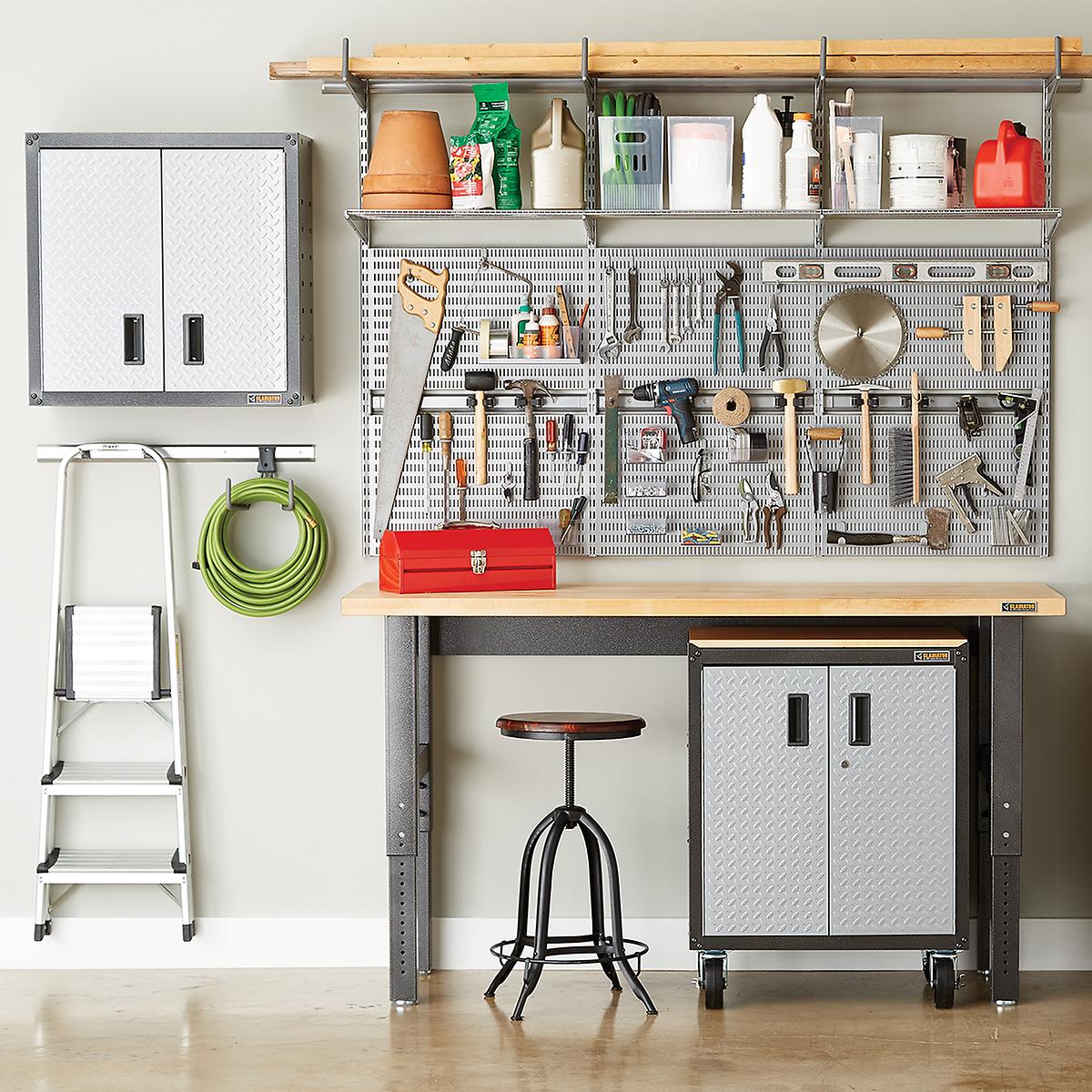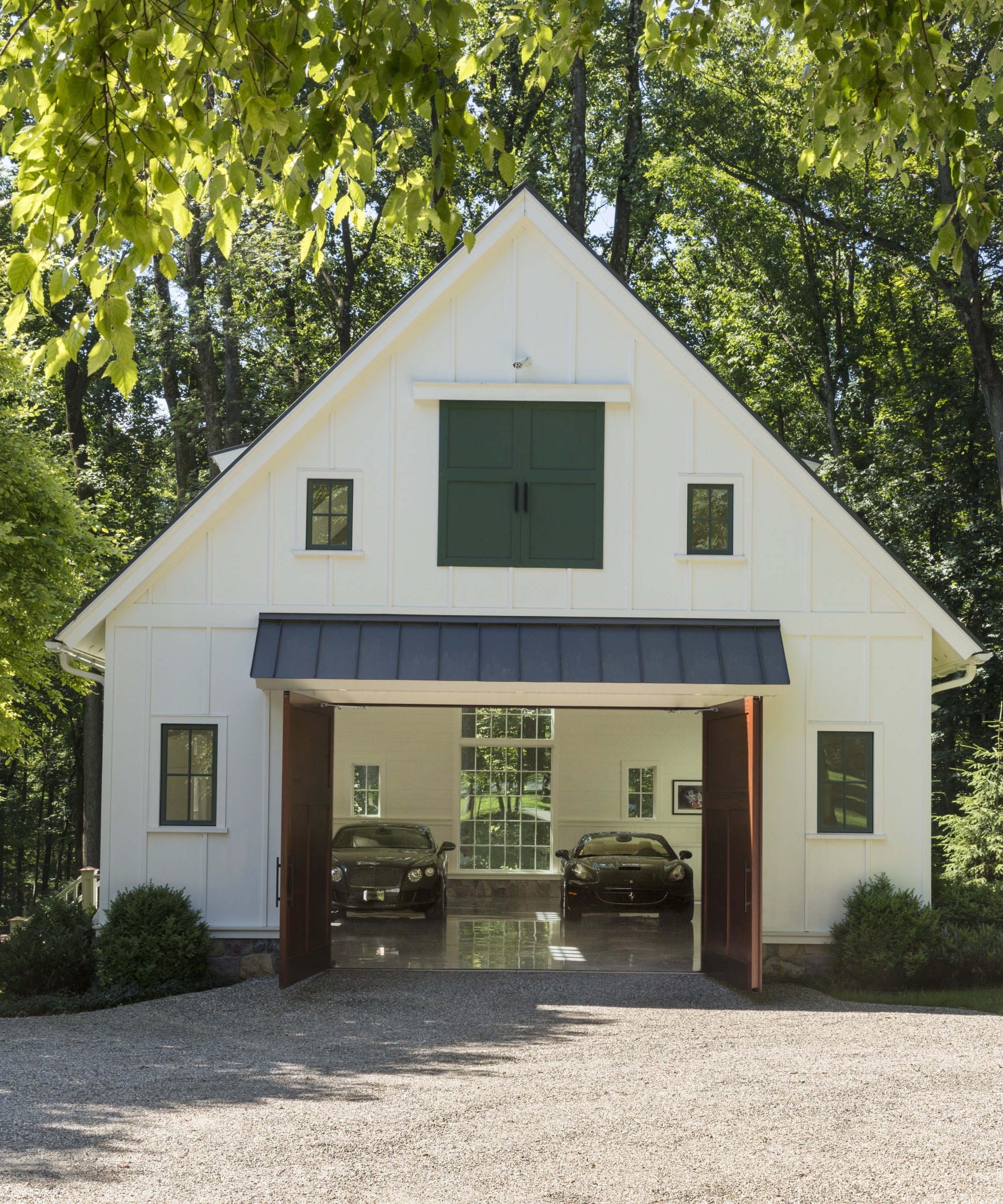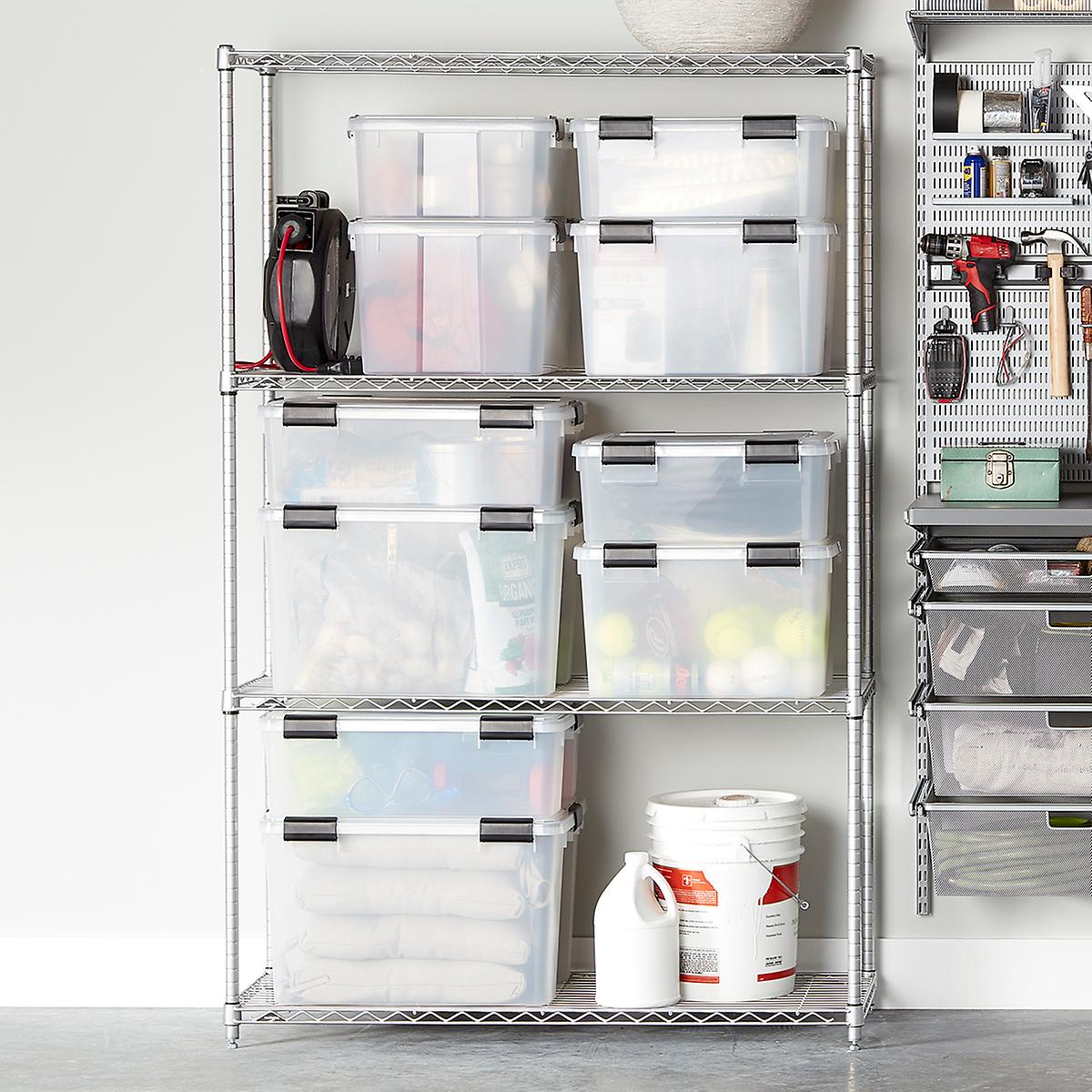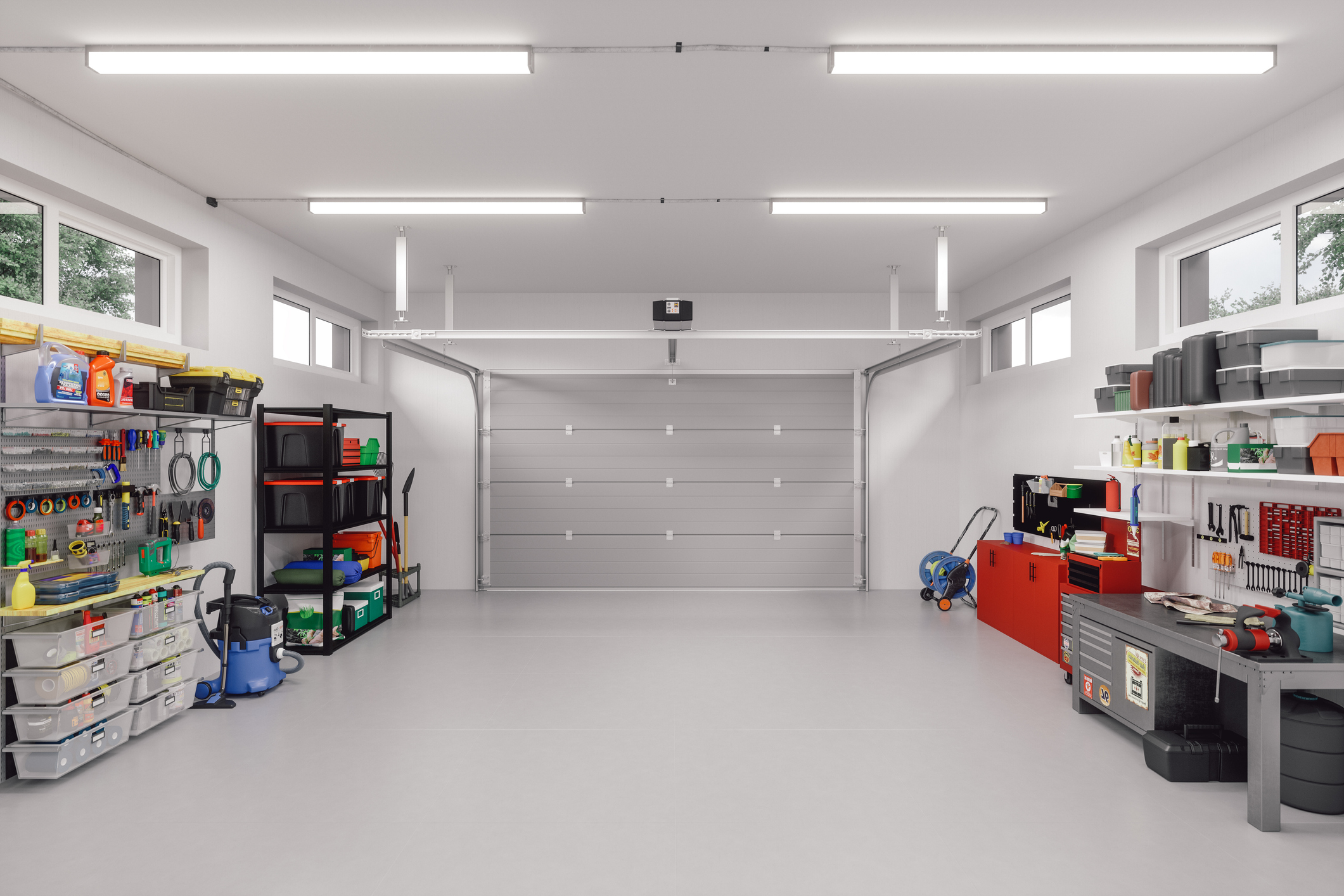
Often the designated drop zone for all things large, messy and muddy (including the car), the thought of organizing a garage can be somewhat overwhelming. While ignoring it might feel like the easier option, it’s worth the effort – there’s more than just a neat and tidy garage at stake.
Incorporating effective storage ideas into your organization system will enable you to take full advantage of the room’s storage potential, which has the added benefit of freeing up space elsewhere in the home.
‘It’s important to keep a garage organized, not just because it looks nice, but because of the impact it can have on your ease of living – no longer will you run the risk of tripping over bikes, helmets, and loose footballs as you walk through your hallway, for example!’, says Amy Stansfield of Wallsauce.
With that in mind, we’ve put together organizational strategies that’ll see you make the most of your garage and ensure it stays clutter-free and functional in the long run, too.
Organizing a garage
Garages have a reputation of being dark and dingy, but that doesn’t have to be the case. It might seem like unnecessary lengths to go to for a space that’s not ‘lived-in’, but you’re much more likely to spend time organizing a garage if it’s somewhere you’re happy to spend time in. Installing windows and bright lighting is a guaranteed way of enhancing the space, but often a deep clean and a lick of paint is all that’s needed, so make that job number one.
1. Start with a declutter

As one of the most popular storage areas in the home, ‘stuff’ does tend to build up in a garage, so decluttering is a good place to start. With such a variation of items to work through – anything from bikes and golf clubs to lightbulbs and Christmas decorations – it’s easy to feel overwhelmed.
To avoid this, set aside several days to organize a garage and draft a plan. Think about how you’ll separate items in your garage, for example ‘keep’, ‘throw’ and ‘donate’, as well as what categories you’ll be sorting your ‘keep’ items into. This will make next steps much easier. If you know there’s going to be a lot of ‘throw’ items, it’s worth hiring a waste removal company in advance, or hiring a van to transport them to your local recycling center.
Design expertise in your inbox – from inspiring decorating ideas and beautiful celebrity homes to practical gardening advice and shopping round-ups.
‘Before you start putting things back, take the chance to check the structural integrity of your garage and ensure it doesn’t require any maintenance. If it does, now’s the time to do it, whilst it’s clear’, advises building specialist Richard Berry of outdoor building specialist, Lidget Compton.
2. Organize by use
It’s no wonder garages so often end up in disarray when you think of all the things they’re expected to hold. The first step to creating order is to group like-items together. Choose categories that work well for you and your household, like outdoor toys, gardening equipment, bikes, DIY tools and so on.
Once you’ve done this, you’ll be well placed to work out the most suitable garage storage ideas for different groupings. Do this one group at a time to avoid the task becoming too daunting and start with the largest items first; smaller items are usually easier to store so can be dealt with afterwards.
3. Create a functional layout
Next, think about how you use these items in your garage and designate areas for them accordingly, which is one of the most important golden rules for a clutter-free garage. Often-accessed sports equipment, bikes and garden necessities stored next to the door, lesser-used tools, hardware and Christmas decorations tucked further back, for example.
If your garage plays host to bulky items such as home gym equipment, a chest freezer or an extra refrigerator, be sure to factor in plenty of space around them to ensure easy access – don’t be tempted to cram items too close to door opening areas (including your car).
4. Establish an effective shelving system

When it comes to organizing a garage, efficient garage shelving ideas are your best friend. When it comes to deciding what system to go for, always have flexibility at the forefront of your mind. The items you store in your garage are likely to come in all shapes and sizes, so designs that feature different sized shelving will create a more useful space overall.
'I like to keep shelves organized by use, so I have one shelf dedicated to car supplies that I use often like windshield wiper fluid, microfiber rags for removing spots off the car, oil and gas cans,' says Mark Feldman, owner of Riverbend Home. 'I have another shelf dedicated to gardening supplies, like trowels, and clippers, things that you always need and like to keep handy. The bottom shelf I tend to reserve for the heavy stuff and change it up seasonally, so depending on the time of year you’ll find it stocked with things potting soil or ice melt, outdoor extension cords, or hoses.'
While built-in designs can be beneficial, particularly in awkward shaped spaces, experts recommend avoiding permanent fixtures. You never know when your needs might change in the future and having the ability to adjust your shelving ideas will ensure you maintain organization in the long run.
5. Corral smaller items
Whether you keep it simple with stackable containers or include drawers and bins somewhere in your organizational system, be sure to factor in storage for smaller items (think tools, hardware, batteries, lightbulbs, and other household essentials). While it may be tempting to hide them away, transparent containers are the more practical choice – you won’t need to sift through to find what you need if you can see inside.
6. Choose containers fit for purpose

Don’t forget that a garage isn’t a lived-in room, so likely hasn’t been designed as one (unless it’s been converted, of course). With that in mind, it’s crucial to choose storage designed for the purpose.
‘Look for durable storage with sturdy lids’, advises Craig Sammells UK & Ireland manager of the Orthex Group. ‘If dampness is an issue, choose water-resistant containers to ensure the contents remain clean and dry – it has the added benefit of protecting against humidity, dust and insects, too’.
Unless you’ve opted for a stackable storage system, choose different sized containers depending on what you’re storing. This should help prevent overfilling… you want to be able to pull out boxes without breaking your back in the process. As an alternative, consider investing in sliding storage to avoid having to move them around to find what you need.
7. Label everything
As the initial organizer, you may well remember the exact location of each item, but the rest of your household likely won’t. Skip the hassle of having to open every storage bin by labeling them clearly. You could even implement a color coded system – either with stickers or with coloured storage boxes – to make things easier. The more coherent your labeling system, the more likely your organization system is to stand the test of time.
8. Keep the floor clear

Whether you use it for storing a car or not, a garage will always feel less cluttered if the floor space is as clear as possible, so invest in organizational systems that will help you keep it that way.
As well as shelving, consider lining the walls with hooks and peg boards – these are useful for hanging coats, shoes, tools and garden equipment’, says Richard Berry. If you have bikes, consider securing racks to the walls; this will keep them safe from damage as well as keep the floor clear’.
9. Utilize the ceiling
Going vertical and using space on the ceiling to hang large, bulky items that won't easily fit elsewhere can be really helpful in expanding storage and therefore giving home to items that can otherwise fill your garage as un-housed clutter.
This might include items you use less often but still need to keep and be able to access, such as a ladder, or an item for a hobby, such as a kayak, or pool items.
Just make sure that if you elevate items to be stored on the ceiling of your garage that they are clear of door mechanisms, hardware and the top of any cars you park inside.
Ceiling rafters are handy for storing lesser-used items, such as Christmas decorations or vacuum-packed seasonal clothing. If you don’t have them, invest in a set of hanging shelves instead.
10. Consider adding a garage mudroom
If you have the space, incorporating garage mudroom ideas into your organization system is a great idea, particularly if you usually enter the house that way anyway. Or if you have pets that love muddy walks. Or children that love muddy walks, for that matter.
While sinks and dog-washing stations are a luxury, your garage mudroom doesn’t need to be elaborate to be practical, nor does it require tonnes of square footage. A simple storage box doubles up nicely as a bench for changing footwear, while a peg rail serves as the perfect place for storing coats, scarves, and general outerwear.
Consider labeling hooks and shelves to make it easier for each family member to keep track of their items – particularly little ones.
Where do I start with organizing my garage?
Garages are notorious for becoming a landing zone for just all manner of items, so the first thing to do is to sort what you have into categories. This can feel overwhelming, so it’s best to draft a plan so you know what you’re doing. We’d also recommend setting aside a few days to get the job done – trying to do it in less time will just cause unnecessary stress.
Take everything out and get rid of any items that are broken or no longer needed. While the garage is clear, take the opportunity to do any maintenance, decorating, or at the very least, give it a good clean. While the space is empty, decide on effective garage storage ideas for the items you have, as well as a functional layout.
How do I plan a garage layout?
Before you start putting things back into place, it’s wise to draw out a rough floor plan, factoring in bulky items such as your car, a chest freezer or gym equipment (don’t forget to include their door opening areas). This will give you a clear idea of the space you’re working with.
Start by grouping items into categories, then designate areas for them accordingly. The items that you use most often should be the easiest to access. The goal is to keep the floor as clear as possible, so store items vertically or up high where you can (fishing rods, skis, brooms, shovels etc all take up less space if stored vertically, too). Use open shelving for bigger items or things you need to locate quickly, and cabinets or closets for smaller items such as seeds, tools, and household essentials.
Consider rearranging your layout seasonally. Snow shovels and salt need only be accessible in the winter for example. Move them to make way for lawn mowers and gardening equipment in the summer. Not only will this make your life easier, but it’ll also ensure you’re keeping on top of organization regularly – take the opportunity to declutter each time, too.

For 10 years, Tara King worked as a Content Editor in the magazine industry, before leaving to become freelance, covering interior design, wellbeing, craft and homemaking. As well as writing for Ideal Home, Style at Home, Country Homes & Interiors, Tara’s keen eye for styling combined with a passion for creating a happy – and functional – family home has led to a series of organization and cleaning features for H&G.
